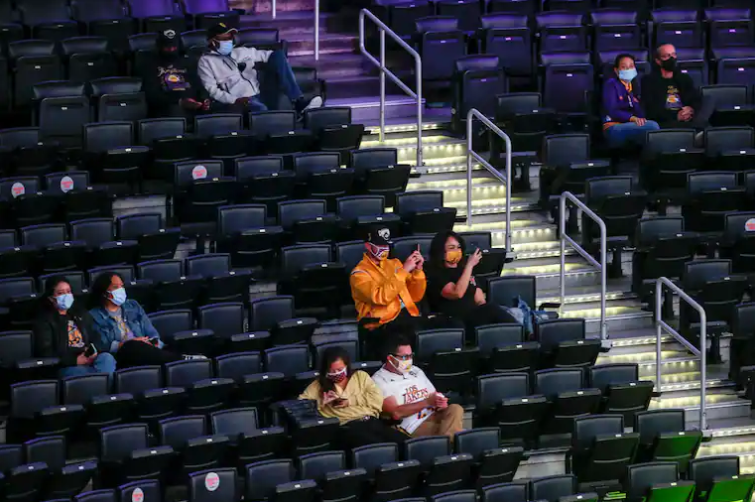
 i_need_contribute
i_need_contribute

Fans sit in small groups during an NBA game between the Celtics and the Lakers in Los Angeles on April 15. (Ringo H.W. Chiu/AP)
The common six-foot social distancing guidance on its own may not be enough to protect people from contracting the coronavirus while spending time indoors, according to a report that examined the virus’s airborne transmission risk.
Researchers from the Massachusetts Institute of Technology argued that not all indoor settings are the same, varying by size, ventilation, air filtration, occupancy and the nature of the activity. While the core premise of the study isn’t new, the research offers more details (and a handy online risk-assessment calculator) to help people better understand what factors in a given indoor setting may increase their risk for catching the coronavirus.
“For airborne transmission, social distancing in indoor spaces is not enough, and may provide a false sense of security,” Martin Z. Bazant, an MIT chemical engineering professor and the paper’s lead author, told The Washington Post in an email.
The research, published in the Tuesday issue of the Proceedings of the National Academy of Sciences of the United States of America, offers guidelines based on mathematical models and environmental assumptions drawn from documented superspreading events.
Even without precise calculations of air circulation, filtration quality and crowd control, there are still basic mitigation measures to understand, said John W.M. Bush, an applied mathematics professor at MIT who co-wrote the report.
“Efficient mask use is the most effective safety measure, followed by room ventilation, then filtration,” Bush told The Post in an email. “And risk increases with the number of occupants and the exposure time, so one should try to spend as little time as possible in crowded indoor spaces.”
The researchers stressed their findings do not suggest that social distancing is ineffective — only that it does not provide sufficient protection in the particular indoor circumstances calculated in their models.
“A common misinterpretation of our study is that it ‘finds’ no effect of social distancing, when in fact, our safety guideline for airborne transmission is derived from the standard assumption of well-mixed indoor air, where distance plays no role,” Bush said.
Throughout the pandemic, most superspreading events have been associated with airborne transmission, including a choir rehearsal in Washington state early in the spread of the virus in the United States and a two-hour bus ride in the Eastern Chinese city of Ningbo, both of which were cited in the study.
Bazant said cigarette smoke offers a useful analogy for the different types of respiratory disease transmission.
“Turbulent puffs of exhaled smoke help us visualize respiratory jets from coughing, speaking or breathing through the mouth or nose, whose concentration decays quickly with distance,” Bazant said. “While secondhand smoke in a well-mixed ‘smoke-filled room’ is analogous to long-range airborne transmission, which depends more on time and occupancy than on physical distance.”
Scientists such as Kimberly Prather, an atmospheric chemist at the Scripps Institution of Oceanography and the department of chemistry and biochemistry at the University of California at San Diego, urged readers to recognize that the PNAS article is based on models and assumptions — including that air in a particular room is “well-mixed” — that may be different in real-world settings.
If an infected person walked into a room, the air does not instantly become evenly mixed, which makes a person standing at a greater distance in a safer position than someone near the person infected with the coronavirus, Prather explained.
The study authors implicitly and explicitly state that airborne transmission poses the greatest risk of infection. Prather and those in her field say they welcome such research and hope it prompts the World Health Organization and the CDC to focus on the primary mechanism by which people become infected with the coronavirus.
The CDC has emphasized that the virus spreads mostly through close contact, via droplets and particles within six feet, though the agency acknowledges the virus can be contagious beyond that distance when suspended in the air.
“There’s a big disconnect; the WHO is still saying ‘wash your hands,’ but it’s not about cleaning surfaces,” Prather told The Post. She argued that too much attention and resources are diverted toward measures such as spraying down surfaces with disinfectant when addressing ventilation and filtration would have a more significant impact on transmission.
“There’s a way to do this — and stay safe,” Prather said. “We’re not trying to shut down restaurants; we’re not trying to shut down schools. Look at Taiwan: They looked at clean air. There are solutions people can have. We don’t have to fly blind.”
Both MIT researchers said they hope their work can help anyone making reopening decisions that are flexible but that still emphasize safety.
“Indeed, our guideline demonstrates when the social distancing guidelines are overly restrictive, and when they are inadequate,” they wrote jointly in an email. “Our guideline also quantifies the relative benefits of improved ventilation, filtration and mask directives, which can inform decisions to reopen or upgrade specific indoor spaces, such as schools and churches.”